Very few fruits are as enjoyable and desirable as Strawberries. The secret to a sweet, richer crop often begins with the best soil. Strawberries prefer soil that drains well but maintains little moisture to prevent the roots from drying. They also thrive in soil that is rich in nutrients. Whether Strawberry is planted in beds or containers, they should get at least 8 hours of direct sun daily. Without enough sun, fruit production can be low, and Strawberries can be sized and lack taste.
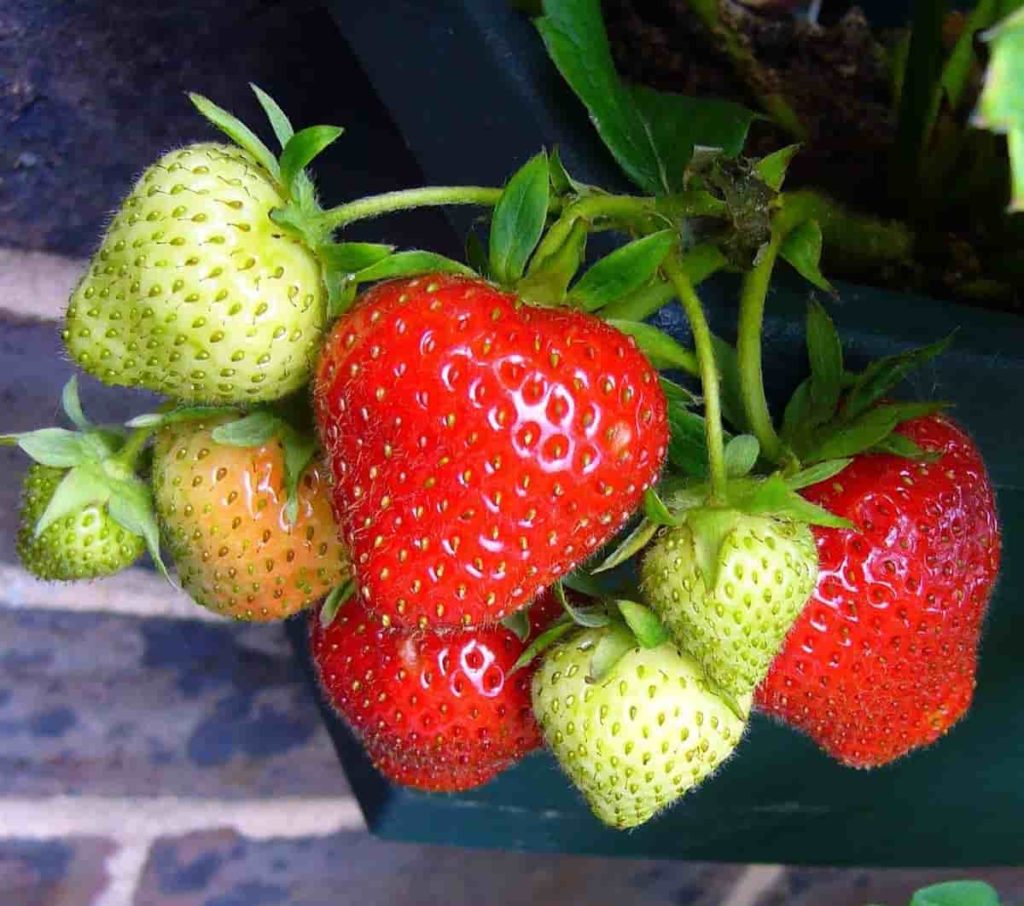
The roots of the Strawberry plant do not like standing water, so the soggy soil will not succeed. On the other hand, the roots also do not want to dry completely, so the soil should be drained quickly while maintaining moisture. The ingredients in the soil, such as coco-coir and perlite, encourage drainage, and they also absorb and release a measure of water gradually, which prevents the roots from drying too much in the water. Grow Strawberries in containers; use only containers with drainage holes underneath them.
How to prepare the soil for Strawberry plants
Soil pH for Strawberries
Strawberries require soil pH between 5.5 and 6.9. Before planting your Strawberries, a soil test helps determine what amendments are needed to adjust the soil pH. Suppose you add elemental sulfur to make the soil acid. Use about 900 grams of elemental sulfur to reduce soil pH by 1 point and 1.5 kg to reduce 1.5 points.
If your soil is sandy, reduce the sulfur content by one-third; if it is heavy, add one-half to it. You can make the soil acidic by using Iron sulfate, aluminum sulfate, or ammonium sulfate; when applying these products, follow the package instructions carefully and adjust the quantity according to your soil test results.
When digging into the soil, adding 2 to 4 inches of well-decomposed compost, manure, pine needles, and peat moss would be better. Sandy soil benefits as compost help soil maintain moisture, while the organic matter in heavy clay helps aerate it, so it drains better.
Preparation of soil for growing Strawberries in pots
Choose a large pot with drainage holes. The best soil mix for Strawberries in containers is 2/3 potting mix and 1/3 compost and aged cow manure. Premium potting mix has composted and aged organic matter and slow-release fertilizer that will feed your plants when they are established. The difference between basic potting mix and premium is premium contains other additives that help you set up plants.
In case you missed it: 20 Common Strawberry Plant Problems: How to Fix Them, Solutions, and Treatment
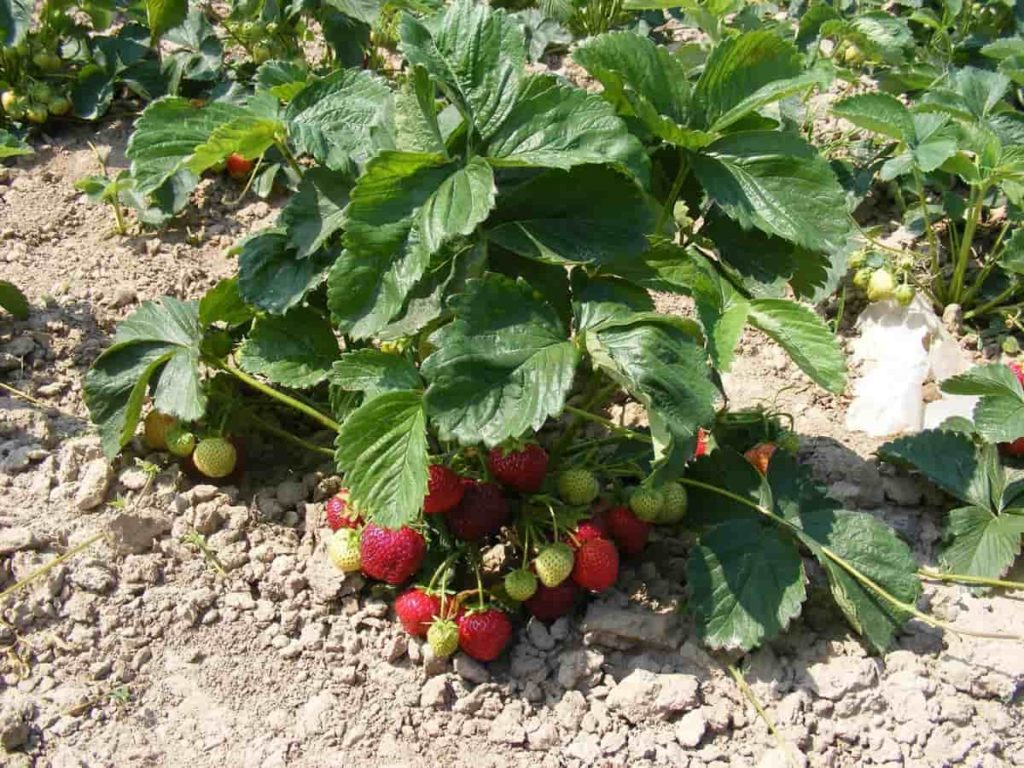
It can include slow-release fertilizer, soil wetters to keep moisture in the soil for longer, and even contain seaweed. Aged cow manure is an excellent ingredient for increasing organic matter and adding extra nutrients to your soil mixture. The aged cow manure is mild fertilizer that will slowly break down into the soil to feed the plants. Make sure to use only aged cow manure as fresh manure can burn plant roots. Compost is another excellent ingredient for mixing through potting soil to grow the best Strawberries possible.
Homemade compost is excellent as it will have a range of nutrients from your food scrap or ingredients. It will have a lot of good soil bacteria and help the potting soil hold water. Mix the ingredients well with the garden fork to ensure they are well mixed. This compound will also help keep the soil water longer to keep Strawberries happy with regular moisture.
Preparation of soil for growing Strawberries on grounds
Strawberries planted in well-prepared soil should produce fruit for at least five years. A proper supply of organic matter in soil is important. Organic matter improves soil structure, provides nutrients, helps promote the growth of soil organisms, and enhances soil water-holding capacity.
If soil’s organic matter is low, improve it before applying with generous amounts of weed-free animal manure, peat moss, or compost. Green manure crops like Buckwheat, grown and incorporated into the soil a year before planting, is a great way to improve the soil. Strawberries are shallow roots, so amending the top 6 to 12 inches of soil is enough to produce an ideal growing medium.
In case you missed it: Hydroponic Strawberry Gardening Techniques, Tips
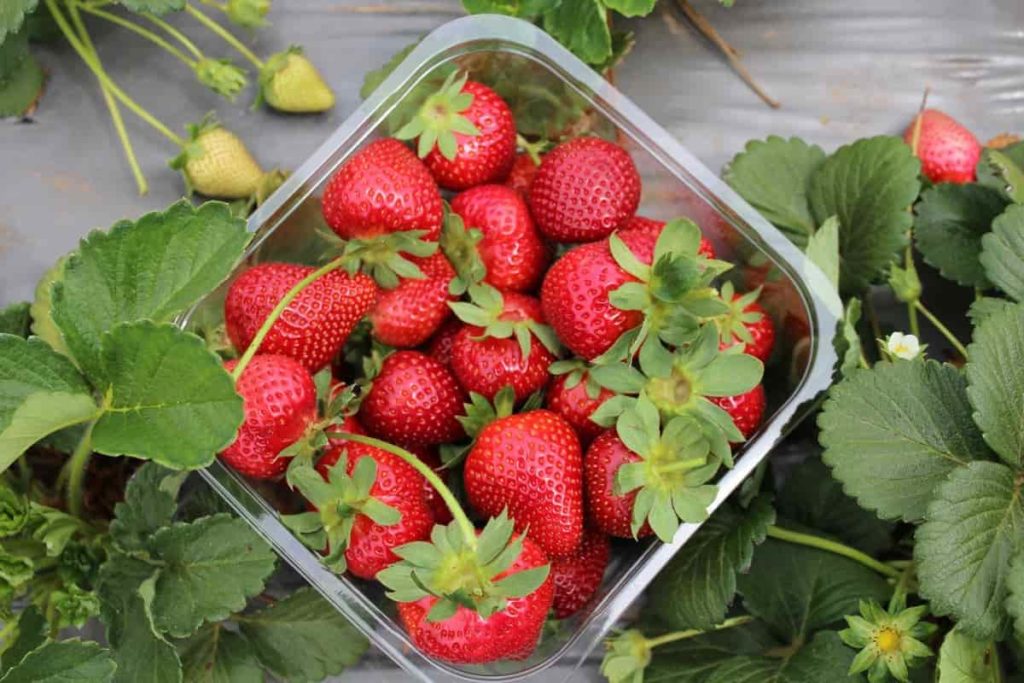
How to grow Strawberries in clay soil
The best soil for Strawberries is high in organic matter and drains well. Sandy loam is ideal for growing Strawberries. Clay soil is also very good for Strawberries if they are improved first with the compost and aged cow manure. Mix through some pelleted chicken manure to feed new plants to grow faster.
If you have clay soil, mix 4 inches or more of compost, and rake up the clay soil into raised beds to improve drainage. If your soil is sandy, cultivate lightly to remove the weeds and mix in an inch of compost or rotten manure. Clay contains a lot of nutrients and holds water for good Strawberry growth.
Soil composting for Strawberries
In addition to slightly acidic soil, Strawberries require organic matter-rich soil. They thrive on pH between 5.5 and 6.9; always, it is important to stay within the best pH range of the plant to get the nutrients it needs and grow to its potential. If the soil’s pH is too low or too high, Strawberries can be smaller than they need, and they cannot produce fruit. Once you check your soil, you can adjust it for the best Strawberry growth.
The Ericaceous compost can help reduce pH in neutral soil. Once you adjust the soil pH and plant Strawberries, they are heavy feeders. You would like two to three inches of compost on the soil surface. Then mix it before planting Strawberries. Wide compost varieties include commercial, organic, and homemade. Well-aged homemade compost is the best fertilizer for Strawberries. Make sure the ingredients are completely broken and resemble soil.
In case you missed it: How to Grow Berries in USA: At Home in Pots, Containers, Indoors, and Tips
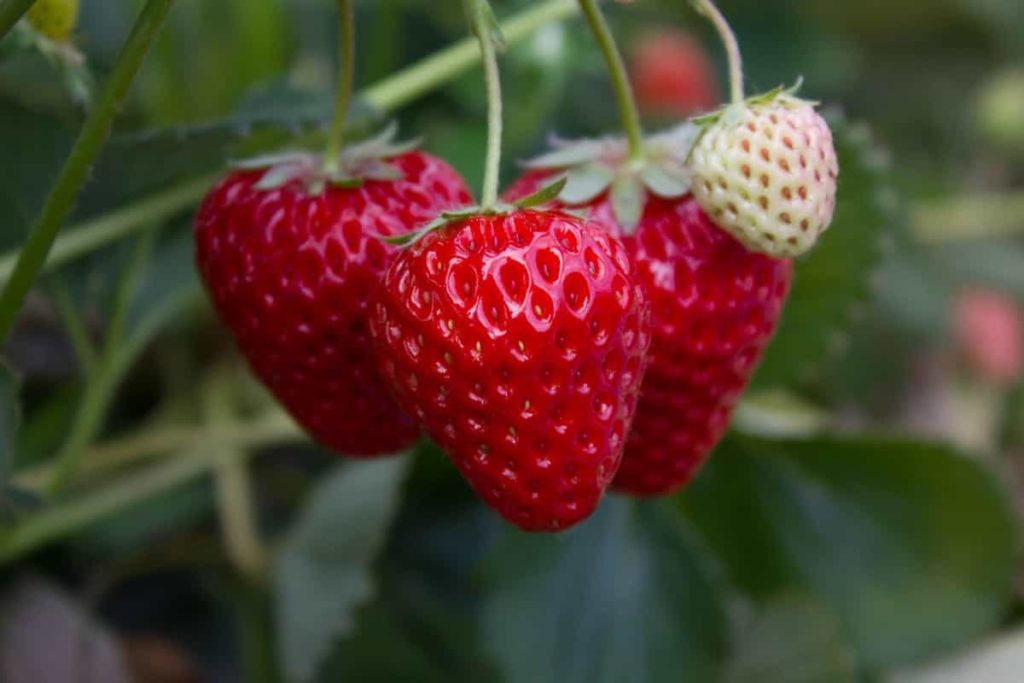
If you can, choose organic compost, and you may be sure there are no leftover pesticides in the mix. You can add Citrus peels, Lemon, Grapefruit, Oranges, and more, and also you can use coffee grounds. You can also add Pine needles, reducing the pH when they decompose. Some people also add diluted vinegar. Strawberries don’t need Ericaceous compost, but they can grow in it and need acidic soil. If you are planting Strawberries in your soil with a neutral pH, the Ericaceous compost will help make the soil more acidic.
Land preparation for Strawberries
Strawberries require about 8 to 10 hours of sunlight every day. Find an area that receives full or partial sunlight that will be good and warm for growing plants. You can remove a few weeds from your hand, if necessary, but don’t choose a location that is more with them. Strawberry likes soft and loose soil, so it must be a couple of times up to the ground before planting. With a hoe or field, go over the entire garden bed and dig up to 12 inches to loosen the soil.
Don’t worry if the soil still looks a little hard-packed; you’ll till it again when you’re with the compost. Strawberry loves fertile, rich, and slightly acidic soils. You can add nutrients and acidity to the soil by working with organic matter. Spread about 4 inches of organic matter over the bed, and use a hoe or tiller to work it well in the soil.
Good organic matter for Strawberries is mature compost, aged manure, and peat moss. Strawberries also need moist but well-draining soil. To achieve this, spread 2 inches of pearlite or vermiculite over the bed and work it in the soil with a hoe or tiller. Perlite and vermiculite retain water, allowing water to be drained through the soil while keeping it moist. Space the holes 18 inches apart and rows that are 24 inches apart.
Holes should only be deep and wide so the root ball can find space. Before planting, use your fingers to spread each Strawberry plant’s roots. Place a Strawberry plant in each hole. Use enough soil to cover the roots. The crown of the plant should equal the soil level; otherwise, the plants can rot. The crown is the area where roots and trunks meet.
Best soil mix for Strawberries
Mix 10 quarts of coconut coir, 5 quarts of perlite, 5 quarts of vermiculite, 5 cups of compost, 2 cups of fine sand, and 2 cups of slow-release fertilizer grains. For Strawberries, choose fertilizer specifically designed for acid-loving plants.
Soil recipe for Strawberries
While a standard loam soil with equal parts of sand, soil, and organic matter is acceptable to Strawberries, a 30% mixture of soil, 30% organic matter, and 40% sand is close to the perfect Strawberry soil mixture.
In case you missed it: Hydroponic Strawberry Gardening Techniques, Tips
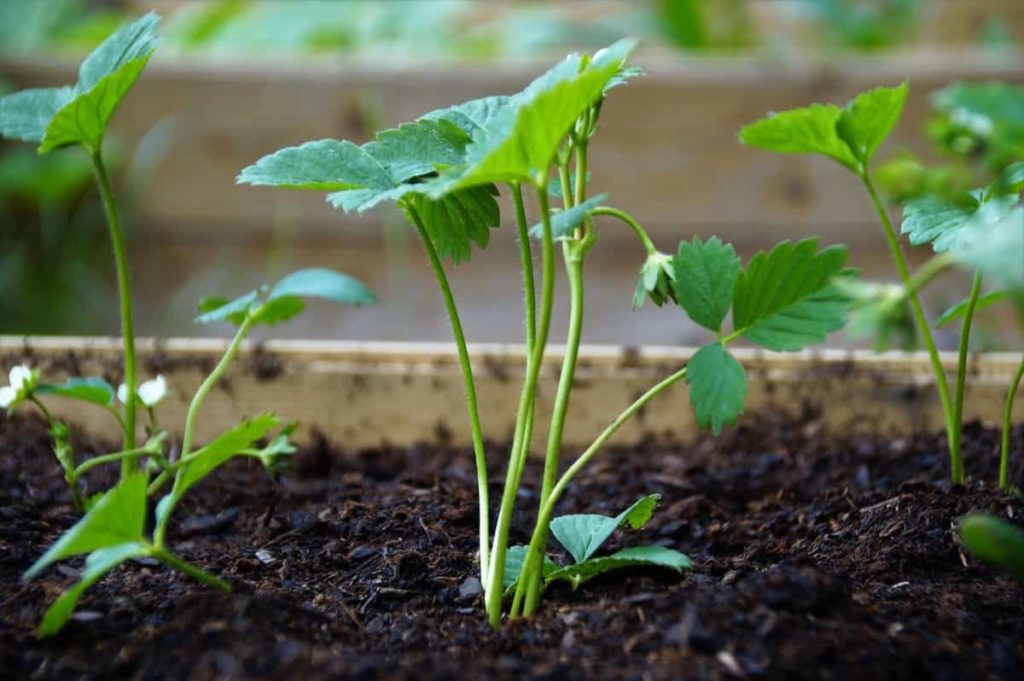
Natural soil amendments for Strawberries
The organic material you choose to add to your soil can significantly affect the number of disease problems your Strawberry plants have. Strawberry seems to be the best organic matter that comes from animals. Crushed eggshells and any animal material that is manure worth making a huge organic matter for your soil. Make sure to compost the material before using it, and leave the bones and animal skins.
Animal manure is used quite successfully by many Strawberry gardeners. This manure can effectively control disease pathogens in the soil and add nitrogen to the soil. Negative aspects of animal manure include smell and the fact that it can add too much nitrogen, reduce fruit quality, or damage plants. Green manure is another good source of organic matter for your Strawberry patch.
Disease-resistant alfalfa, popular with many gardeners, is usually grown in the garden as a so-called cover crop. Plant manure does not smell like animal manure and releases nitrogen more slowly. It can also be relatively cheap compared to other sources of organic matter. And can cultivate only soil to cover crops, while animal manures must be spread over the garden before they can be cultivated. The biggest difficulty in plant manure is that it is generally less effective in controlling soil-produced diseases than organic matter obtained from animals.
What to do with soil when growing Strawberries
Companion planting is a useful garden design strategy that combines compatible plants to take advantage of their mutually beneficial features. Some plants attract beneficial pollinators and predatory insects, repel pests and enhance their flavor and overall growth. Strawberry makes perfect companions for many other plants in vegetable gardens and decorative beds. They are perfect for planting beans with long crops like Asparagus and Rhubarb as they have shallow roots.
Legumes such as Basil, Borage, Dill, Parsley, Thyme, and Sage attract pollinators. These herbs also attract predatory insects that feed on pests such as aphids, thrips, spider worms, and white flies. Their strong aroma also repels some insects. Beans and Peas, like legumes, are powerful nitrogen fixers. They are associated with soil bacteria that allow them to convert atmospheric nitrogen, which most other plants do not use, into ammonium nitrate absorbed by plant roots.
Allium family members such as Chives, Garlic, Onions, and Shallot effectively repel insects like aphids, carrot flies, flea beetles, mosquitoes, deer, and rabbits. Ideal companions for Strawberries are Lettuce and Spinach. This combination of plants reportedly improves the taste of all three crops. Large leaves can also help hide Strawberries from hungry birds.
In case you missed it: Growing Organic Strawberries On Terrace – In Pots
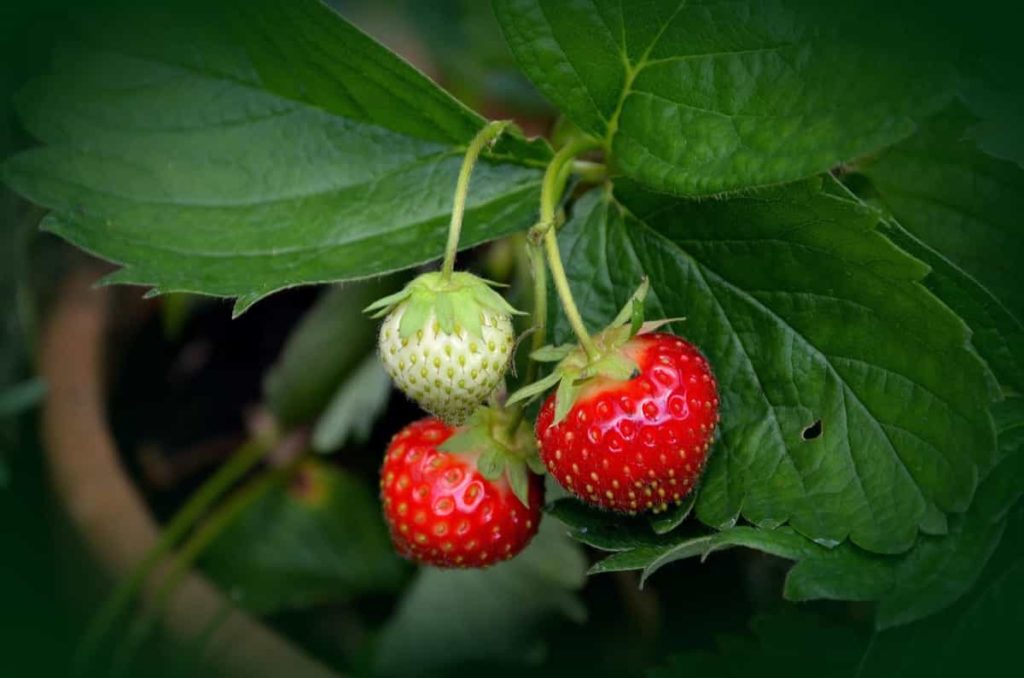
Avoid planting Strawberries near the brassicas, such as Broccoli, Cabbage, Cauliflower, Kale, and Kohlrabi. These plants can prevent each other’s growth. Strawberries are also highly sensitive to verticillium wilt. They should be kept away from similar weak plants like Eggplant, Peppers, Potatoes, Tomatoes, Melons, and Pumpkins to help keep your garden disease-free.
Conclusion
The most important thing about soil for Strawberries is that they should be fertile. To help grow their Strawberry plants and produce the largest crop possible, it is important to ensure that their growing environment meets their needs. Strawberries are not overripe but have certain requirements that need to be met, especially regarding the soil.
If Strawberries don’t get enough nutrients, they will never fully grow to their full potential or get delicious berries. Create the best growing environment for your Strawberries by using this article, which will tell you how to prepare the soil for Strawberries.
- How to Grow Hibiscus from Flower
- Plantation Ideas for Home Decoration: A Beginners Guide
- Flower Garden Designs and Layouts for Beginners
- Planting and Spacing Techniques in Papaya: A Beginner’s Guide
- Growing Gold: Essential Techniques for Planting Pineapples
- How to Make Kalanchoe Plant Bushy: Home Remedies and Solutions
- 11 Reasons Why Your Gardenia is Not Blooming: Home Remedies and Solutions
- Eco Elegance: The Guide to Designing a Drought-Tolerant Landscape
- Gardening on a Slope: Strategies for Hillside Landscaping
- Nourish and Flourish: Top Organic Mulches for Thriving House Plants
- Everything You Want to Know about Indian Mogra Flower: Discover Uses and Growing
- Green Thumb Success: Expert Tips for Cultivating Greenhouse Pumpkins All Year Round
- Maximize Growth & Flavor: The Ultimate Guide to Companion Planting in Herb Gardens
- How to Control Rhododendron Problems Naturally: Home Remedies and Organic Ways to Fix Them
- Natural Magic: The Remarkable Benefits of Cinnamon for Plants
- Best Steps to Revive Dying Tulip with Natural and Organic Treatment
- 10 Reasons Why Your Angel Trumpet is Not Blooming: Remedies and Treatment
- How to Fix Periwinkle Leaf and Flower-Related Problems: Natural Remedies and Solutions
- How to Fix Zinnias Leaf and Flower Problems: Discover Natural and Home Remedies
- Organic Steps to Induce Lemon Tree Flowers: A Comprehensive Guide
- Bloom Booster: Crafting the Perfect Homemade Bougainvillea Fertilizer
- Optimizing Growth: A Guide to Applying NPK Fertilizer for Potted Plants
- 10 Best Homemade Fertilizers for Rubber Plant: DIY Recipes and Application Method
- How to Boost Female Pumpkin Flowers: Effective Steps for More Flowers and High Yields
- Transform Your Indoor Garden: Top Benefits of Pink Salt for Houseplants
- 10 Best Homemade Fertilizers for Peacock Plants (Calathea): Easy DIY Guide
- Unlock Blooms: 9 Reasons Why Your Potted Chrysanthemum is Not Blooming
- 8 Reasons Why Your Potted Hibiscus is Not Blooming: Fix it with Simple Solutions
- Unlock Blooms: 9 Key Reasons Your Potted Frangipani Won’t Flower
- 10 Reasons Why Is My Ice Plant Not Blooming: Remedies and Treatment
- 10 Reasons Why My Potted Hydrangea Not Blooming: Treatment and Remedies
- 10 Reasons Why is My Wisteria Not Blooming: Remedies and Treatment
- 10 Reasons Why is My Goldfish Plant Not Blooming: Remedies and Treatment
- Maximize Your Space: Ultimate Guide to Balcony Gardening with Grow Bags
- 10 Reasons Why Your Iris is Not Blooming: Remedies and Treatment
- 10 Reasons Why Your Anthurium Plant is Not Blooming: Treatment and Remedies